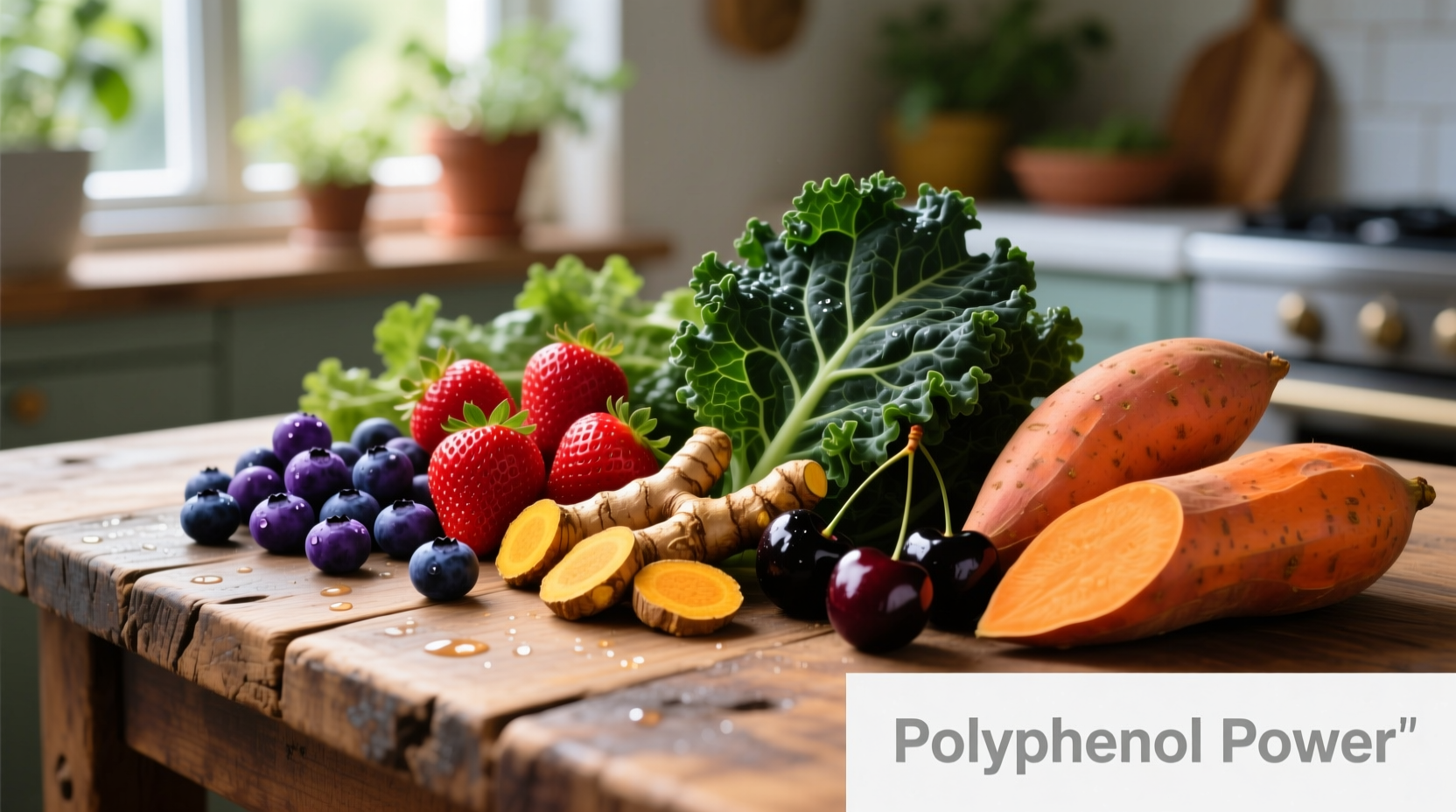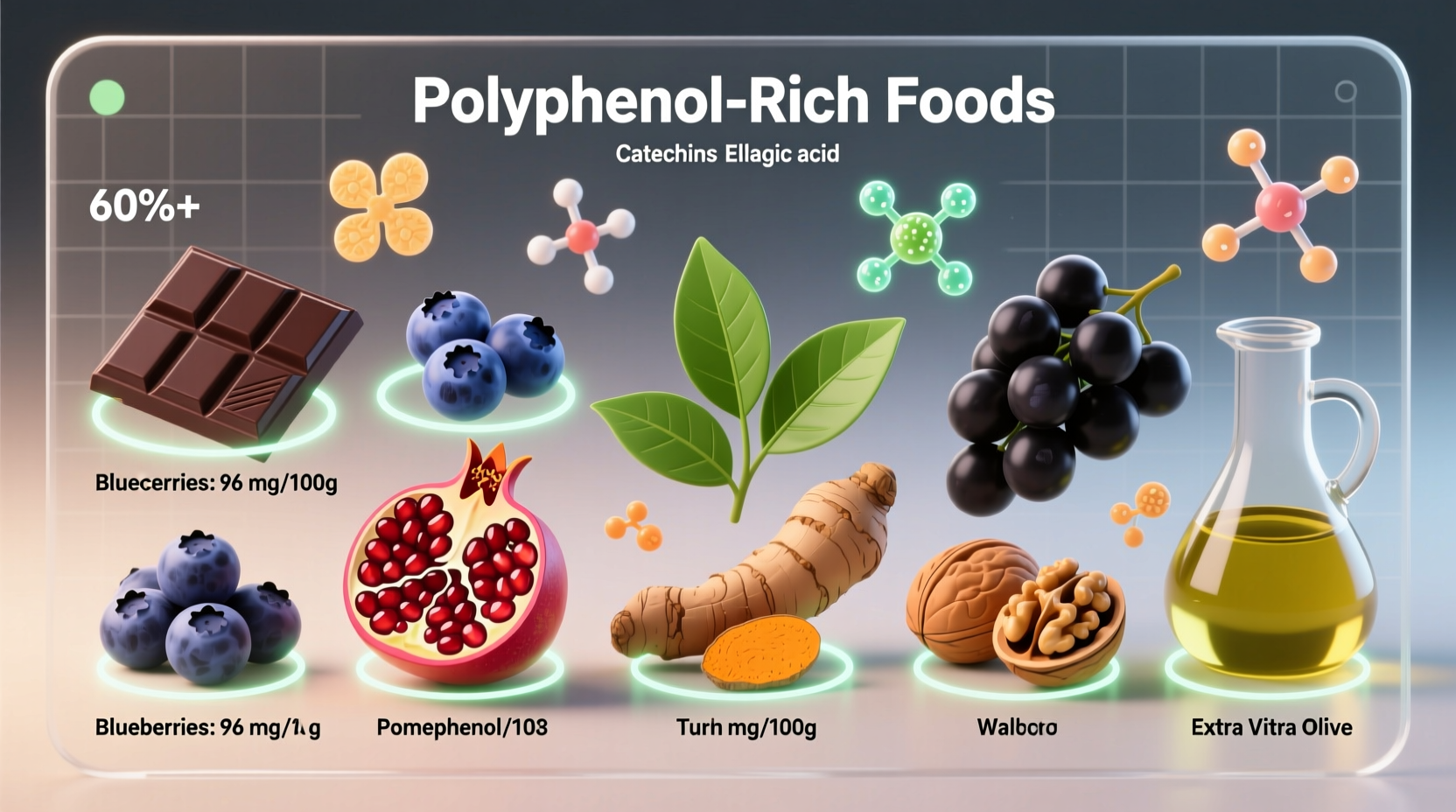Understanding which foods contain the highest concentrations of polyphenols can transform your approach to healthy eating. These powerful plant compounds aren't just buzzworthy nutrition terms—they're scientifically proven defenders against oxidative stress and inflammation. Our comprehensive guide cuts through the noise to deliver precisely which foods deliver the most polyphenol punch, backed by the latest nutritional research.
Why Polyphenols Matter for Your Health
Polyphenols represent one of nature's most potent antioxidant families, with over 8,000 different compounds identified across plant foods. These naturally occurring substances serve as plants' defense mechanisms against environmental stressors, and when we consume them, they provide similar protective benefits for our bodies. Research published in the American Journal of Clinical Nutrition confirms that regular polyphenol consumption correlates with reduced risk of cardiovascular disease, improved cognitive function, and better metabolic health.
Unlike isolated antioxidant supplements, the polyphenols found in whole foods work synergistically with other nutrients and fiber, creating what nutrition scientists call the "food matrix effect." This means you'll gain more health benefits from eating a handful of blueberries than taking a polyphenol supplement—your body processes these compounds more effectively when they come in their natural food context.
Your Complete Polyphenol Food Guide
Navigating the world of polyphenol-rich foods becomes straightforward when organized by food categories. We've compiled the most current data from USDA FoodData Central and peer-reviewed research to show exactly where to find these valuable compounds.
Berries: Nature's Polyphenol Powerhouses
Berries consistently rank among the most polyphenol-dense foods available. While all berries contain beneficial compounds, research shows significant variations:
| Berry Type | Polyphenols (mg per 100g) | Key Compounds |
|---|---|---|
| Elderberries | 665 | Anthocyanins, flavonols |
| Cranberries | 392 | Proanthocyanidins |
| Blackberries | 262 | Ellagic acid, anthocyanins |
| Blueberries | 198 | Anthocyanins, chlorogenic acid |
| Strawberries | 156 | Ellagic acid, anthocyanins |
For maximum benefit, choose frozen wild blueberries over cultivated varieties—they contain up to 30% more anthocyanins. The USDA Food and Nutrition Information Center confirms that berries maintain their polyphenol content remarkably well during freezing, making them a year-round option for consistent intake.
Spices and Herbs: Concentrated Polyphenol Sources
Surprisingly, many common spices contain extraordinary concentrations of polyphenols. Just one teaspoon can deliver more polyphenols than an entire serving of many fruits:
- Cloves (1,079 mg per gram) - The undisputed champion of polyphenol density
- Cumin (280 mg per teaspoon) - Adds earthy flavor while delivering significant antioxidants
- Oregano (160 mg per teaspoon) - Particularly high in rosmarinic acid
- Cocoa powder (100 mg per tablespoon) - Choose natural, non-alkalized varieties
According to research from the National Institutes of Health, incorporating spices into daily cooking represents one of the most effective strategies for increasing polyphenol intake without significantly altering eating habits. Try adding a pinch of cloves to your morning coffee or smoothie for an unexpected polyphenol boost.
Dark Chocolate: The Guilt-Free Indulgence
When it comes to polyphenol-rich treats, dark chocolate stands apart. The key factor determining polyphenol content is cocoa percentage—70% or higher delivers significant benefits:
- 70-85% dark chocolate: 1,660 mg polyphenols per 100g
- Milk chocolate: Only 200 mg per 100g (due to lower cocoa content)
- Raw cacao nibs: Highest concentration at approximately 5,000 mg per 100g
The Harvard T.H. Chan School of Public Health recommends consuming 20-30 grams (about 1 ounce) of dark chocolate daily for optimal benefits without excessive calorie intake. Look for products processed with minimal heat treatment, as high temperatures can degrade delicate polyphenol compounds.

Maximizing Polyphenol Absorption: Practical Strategies
Simply eating polyphenol-rich foods isn't enough—you need to optimize absorption to reap maximum benefits. Consider these evidence-based approaches:
Smart Food Pairing Techniques
Research shows that combining certain foods enhances polyphenol bioavailability:
- Fat pairing: Consuming polyphenol-rich foods with healthy fats (like olive oil or avocado) increases absorption of fat-soluble compounds
- Vitamin C boost: Adding citrus to tea or berry dishes improves flavonoid absorption by up to 30%
- Avoid milk with tea: Casein in dairy can bind to tea polyphenols, reducing absorption by 25%
Preparation Methods That Preserve Polyphenols
How you prepare foods significantly impacts their polyphenol content:
- Minimal processing: Whole berries contain more polyphenols than juice or puree
- Cold brewing: For tea, cold brewing preserves more delicate polyphenol compounds than hot water
- No peeling: Many fruits contain highest polyphenol concentrations in their skins
Important Context: When Polyphenols Need Caution
While polyphenols offer tremendous health benefits, certain contexts require awareness:
- Medication interactions: High polyphenol intake may interfere with blood thinners like warfarin
- Iron absorption: Tannins in tea and coffee can reduce non-heme iron absorption by up to 50%
- Individual variations: Gut microbiome composition affects how individuals process polyphenols
The European Food Safety Authority notes that while polyphenols are generally safe, extremely high intakes from supplements (not whole foods) may cause digestive discomfort in sensitive individuals. For most people, obtaining polyphenols through food sources presents no risks and offers significant health advantages.
Evolution of Polyphenol Research: Key Milestones
Understanding of polyphenols has evolved dramatically over the past century:
- 1930s: Vitamin C discovery overshadows early polyphenol research
- 1950s-1970s: Recognition of flavonoids' antioxidant properties begins
- 1990s: French Paradox study highlights red wine polyphenols' cardiovascular benefits
- 2000s: Development of accurate polyphenol measurement techniques (Folin-Ciocalteu method)
- 2010s: Recognition of gut microbiome's role in polyphenol metabolism
- 2020s: Personalized nutrition approaches considering individual polyphenol metabolism
This research evolution explains why earlier nutrition advice sometimes overlooked these compounds—scientific tools to properly study them simply didn't exist until recently. Today's understanding represents a convergence of nutritional science, biochemistry, and microbiome research.
Building Your Daily Polyphenol Plan
Creating a sustainable polyphenol-rich eating pattern requires practical integration into your existing routine:
- Breakfast: Add berries and cinnamon to oatmeal with a splash of almond milk
- Lunch: Include artichoke hearts and olives in salads with olive oil dressing
- Snack: Choose a small square of dark chocolate with a handful of pecans
- Dinner: Incorporate herbs and spices liberally in cooking, serve with red wine (optional)
Nutrition researchers at the University of California have developed the concept of "polyphenol density"—similar to energy density but measuring beneficial compounds per calorie. Their studies show that consistently choosing high polyphenol-density foods correlates with better long-term health outcomes, regardless of specific dietary patterns followed.











 浙公网安备
33010002000092号
浙公网安备
33010002000092号 浙B2-20120091-4
浙B2-20120091-4